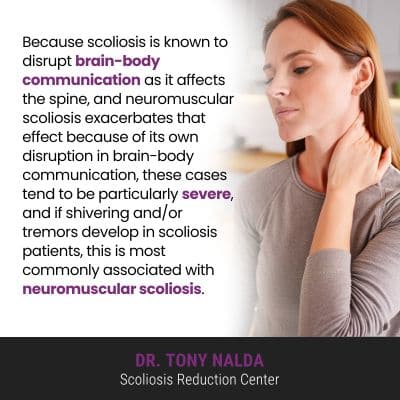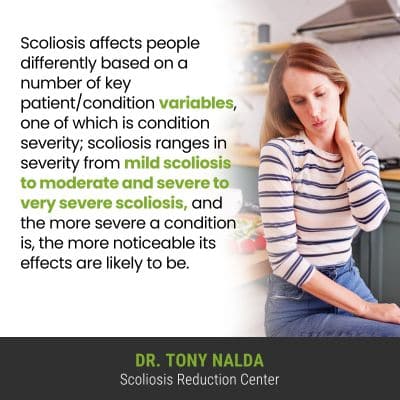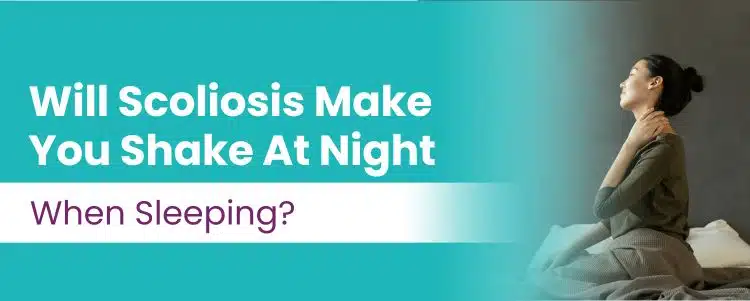Scoliosis can affect sleep in different ways; for adults, back pain can keep them awake and make it difficult to get comfortable, and for those wearing a scoliosis brace at night as part of treatment, that can also be challenging. As a progressive condition, a scoliosis diagnosis can also affect a patient’s mental health: all things capable of affecting sleep.
Scoliosis can affect the spine, its surrounding muscles, nerves, and the nervous system; remember, the brain and spine work together to form the central nervous system. While shaking isn’t a common effect of scoliosis, nerve compression can be associated with tremors.
Let’s start with how scoliosis can affect the nervous system, as this effect is the most likely to cause tremors (shaking).
Defining Scoliosis
The spine is not straight; in fact, when viewed from the sides, it will take on a soft ‘S’ shape, and when seen from the front and/or back, it looks straight, and this is because of the three main spinal sections and their characteristic curvature types.
These curves are key to spinal health and function; the size of the these curves can vary from person to person, and as long as they fall within a healthy and normal range, they won’t be problematic, but if a curve becomes under- or over-pronounced, or the spine starts to bend and twist unnaturally, problems occur.
Scoliosis causes the spine to lose one or more of its healthy curves as an unhealthy sideways curve that also rotates develops, and this introduces a lot of uneven forces to the spine, its surroundings, and the entire body.
In addition, scoliosis is a progressive condition, so treatment options are about how best to manage a life-long condition, and its effects are likely to increase over time, particularly if left untreated, or not treated proactively.
So the effects of scoliosis can change over time because the condition is always changing, and while we don’t know why most cases of scoliosis develop initially, we do know it’s growth that triggers progression, making childhood scoliosis patients the most at risk for rapid progression and increasing effects.
So now let’s talk about tremors and if there is an association between scoliosis and shaking during sleep.
Scoliosis Shivering
Scoliosis shivering is not a common condition effect, but as such a highly-variable spinal condition, no two cases are the same, and just because one patient experiences a certain symptom doesn’t mean others will.
Shivering can be induced by changes in temperature, being cold, and/or neurological issues causing tremors to occur.
As scoliosis isn’t known to affect a person’s body temperature, or the ability to regulate body temperature, shivering brought on by changes in temperature is not considered an effect of scoliosis, but what about nerve issues?
Remember, as the brain and spine work in tandem to form the central nervous system (CNS), and as scoliosis causes an unnaturally-curved and bent spine, the nerves within the spinal cord, and where they exit the spine, can be affected.
Scoliosis becomes a compressive condition once skeletal maturity has been reached, so this happens in adulthood, and when it does, the spine and its surroundings are vulnerable to uneven pressure; in young patients whose spines are still growing, the constant lengthening motion of growth counteracts the compressive force of the unnatural spinal curve.
It’s compression that causes the majority of scoliosis pain, and this can involve muscle pain, chronic back pain, mild and intermittent back pain, and radiating pain into the extremities due to nerve compression.
Tremors and Scoliosis

Tremors are movements that affect the body and are out of the person’s control; they involve involuntary muscle contractions that mainly affect the hands, arms, head, trunk, legs, feet, and the facial muscles.
Tremors can be mild, severe, affect one side of the body, affect both sides of the body, can appear and disappear, their occurrence can be isolated, or they can be caused by a larger issue.
Tremors can affect fine motor control and/or gross motor control, and fine motor control involves small movements like pinching the fingers together, while gross motor control controls larger movements regulated by larger muscle groups working together, like during jogging.
When it comes to tremors and scoliosis, there are also different types of scoliosis to consider, and the type that’s most likely to be associated with tremors while sleeping, or any time, is neuromuscular scoliosis (NMS).
Neuromuscular Scoliosis and Tremors
Neuromuscular scoliosis develops because there is a larger neuromuscular condition causing the development of the scoliosis, and these cases are severe and atypical; the neuromuscular condition causing the scoliosis (spina bifida, cerebral palsy, muscular dystrophy) has to be the focus of treatment.
Neuromuscular conditions cause a disconnect between the brain, the spine, and the muscles and/or connective tissues that support the spine.
Because scoliosis is known to disrupt brain-body communication as it affects the spine, and neuromuscular scoliosis exacerbates that effect because of its own disruption in brain-body communication, these cases tend to be particularly severe, and if shivering and/or tremors develop in scoliosis patients, this is most commonly associated with neuromuscular scoliosis.
Scoliosis is an asymmetrical condition as its uneven forces disrupt the body’s overall symmetry, and this can cause a muscular imbalance and lead to muscle contractions, which in cases of neuromuscular scoliosis tend to be more severe because there is a larger medical condition shaping the scoliosis.
Some neuromuscular scoliosis patients become nonambulatory (unable to walk on their own), and these cases are severe and can carry a number of effects that typical cases of idiopathic scoliosis don’t commonly include, like tremors caused by neuromuscular issues.
So as we’ve now determined that tremors and shivering aren’t considered a common effect of typical idiopathic scoliosis, but that tremors can be a part of living with neuromuscular scoliosis, what are the most common symptoms of the structural spinal condition?
Common Scoliosis Effects
The most common effect of scoliosis differs between children and adults, and as children are more commonly diagnosed, adolescent idiopathic scoliosis being the most prevalent type, let’s start with how scoliosis affects children.
Scoliosis affects people differently based on a number of key patient/condition variables, one of which is condition severity; scoliosis ranges in severity from mild scoliosis to moderate and severe to very severe scoliosis, and the more severe a condition is, the more noticeable its effects are likely to be.
In children, the most common effects involve postural changes:
- Uneven shoulders
- Uneven shoulders blades
- Development of a rib cage arch
- Uneven hips
- Arms and legs that appear to hang at different lengths

In addition, as the condition disrupts the body’s overall symmetry, changes to balance, coordination, and gait can also be common.
Idiopathic scoliosis has no known cause, but we know that growth triggers progression, so adolescents going through the rapid and unpredictable growth spurts of puberty are the most at risk for rapid-phase progression.
In adult patients, as discussed, scoliosis is compressive, so pain is the most common effect, and it is the main symptom that brings adults in to see me for a diagnosis and treatment.
Adults will also experience postural changes that include a prominent lean to one side, and as spinal degeneration comes into effect for older adults, progressive rates can increase in adults.
Conclusion
So can scoliosis cause sleep problems: yes, it can. Scoliosis can make it harder to get comfortable because of the spine’s unnatural bend and twist, and muscles can also be sore as a result, and in adult scoliosis, pain can make it hard to get a good night’s sleep.
Can scoliosis cause shivering when sleeping? If the central nervous system is affected, and/or if a muscular imbalance has developed and is causing muscle contractions, tremors can develop, but this isn’t considered a common effect of scoliosis, particularly in conditions that are being proactively treated.
There are two main ways to address scoliosis with treatment, and that includes a traditional surgical response (spinal surgery), or a conservative nonsurgical approach, and this involves multiple scoliosis-specific treatment disciplines so conditions can be impacted on every level.
When addressed proactively, scoliosis can be highly treatable, and this involves treatment being started as close to the time of diagnosis as possible, working towards a curvature reduction on a structural level, increasing core strength so the spine is optimally supported by its surrounding muscles, corrective bracing, and rehabilitation.
There are three main spinal sections that include the cervical spine, the thoracic spine, and the lumbar spine.
In most typical cases of idiopathic scoliosis, curves bend to the right, away from the heart, but in some atypical cases, like in neuromuscular scoliosis patients, curves can bend to the left, towards the heart, and as the scoliosis develops due to a larger neuromuscular condition, this is the condition type most capable of causing shivering and tremors.
In many cases of scoliosis, treatment can be applied before the spinal nerves are affected, and this can minimize condition effects that involve the nervous system being affected and causing tremors.
Here at the Scoliosis Reduction Center®, I want to help patients have the best possible quality of life, and that includes being proactive with treatment so condition effects can be minimized and the need for surgical treatment in the future can be avoided.




